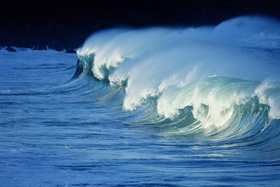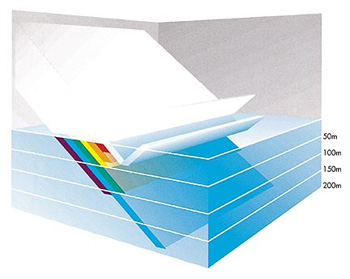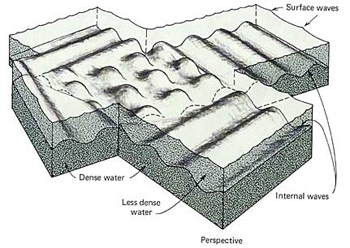The Quran on Deep Seas and Internal Waves
Description: The Quranic account of life in the deep seas, the darkness therein, and how it confirms modern scientific findings.
- By islam-guide.com
- Published on 02 Mar 2006
- Last modified on 04 Dec 2014
- Printed: 1,816
- Viewed: 117,300 (daily average: 17)
- Rated by: 222
- Emailed: 90
- Commented on: 3
God has said in the Quran:
“Or (the unbelievers’ state) is like the darkness in a deep sea. It is covered by waves, above which are waves, above which are clouds. Darknesses, one above another. If a man stretches out his hand, he cannot see it....” (Quran 24:40)
 This verse mentions the darkness found in deep seas and
oceans, where if a man stretches out his hand, he cannot see it. The darkness
in deep seas and oceans is found around a depth of 200 meters and below. At
this depth, there is almost no light (see figure 1). Below a depth of 1000
meters there is no light at all.[1] Human
beings are not able to dive more than forty meters without the aid of
submarines or special equipment. Human beings cannot survive unaided in the
deep dark part of the oceans, such as at a depth of 200 meters.
This verse mentions the darkness found in deep seas and
oceans, where if a man stretches out his hand, he cannot see it. The darkness
in deep seas and oceans is found around a depth of 200 meters and below. At
this depth, there is almost no light (see figure 1). Below a depth of 1000
meters there is no light at all.[1] Human
beings are not able to dive more than forty meters without the aid of
submarines or special equipment. Human beings cannot survive unaided in the
deep dark part of the oceans, such as at a depth of 200 meters.

Figure 1: Between 3 and 30 percent of the sunlight is reflected at the sea surface. Then almost all of the seven colors of the light spectrum are absorbed one after another in the first 200 meters, except the blue light. (Oceans, Elder and Pernetta, p. 27.)
Scientists have recently discovered this darkness by means of special equipment and submarines that have enabled them to dive into the depths of the oceans.
We can also understand from the following sentences in the previous verse, “...in a deep sea. It is covered by waves, above which are waves, above which are clouds....”, that the deep waters of seas and oceans are covered by waves, and above these waves are other waves. It is clear that the second set of waves are the surface waves that we see, because the verse mentions that above the second waves there are clouds. But what about the first waves? Scientists have recently discovered that there are internal waves which “occur on density interfaces between layers of different densities.”[2] (see figure 2).

Figure 2: Internal waves at interface between two layers of water of different densities. One is dense (the lower one), the other one is less dense (the upper one). (Oceanography, Gross, p. 204.)
The internal waves cover the deep waters of seas and oceans because the deep waters have a higher density than the waters above them. Internal waves act like surface waves. They can also break, just like surface waves. Internal waves cannot be seen by the human eye, but they can be detected by studying temperature or salinity changes at a given location.[3]
























